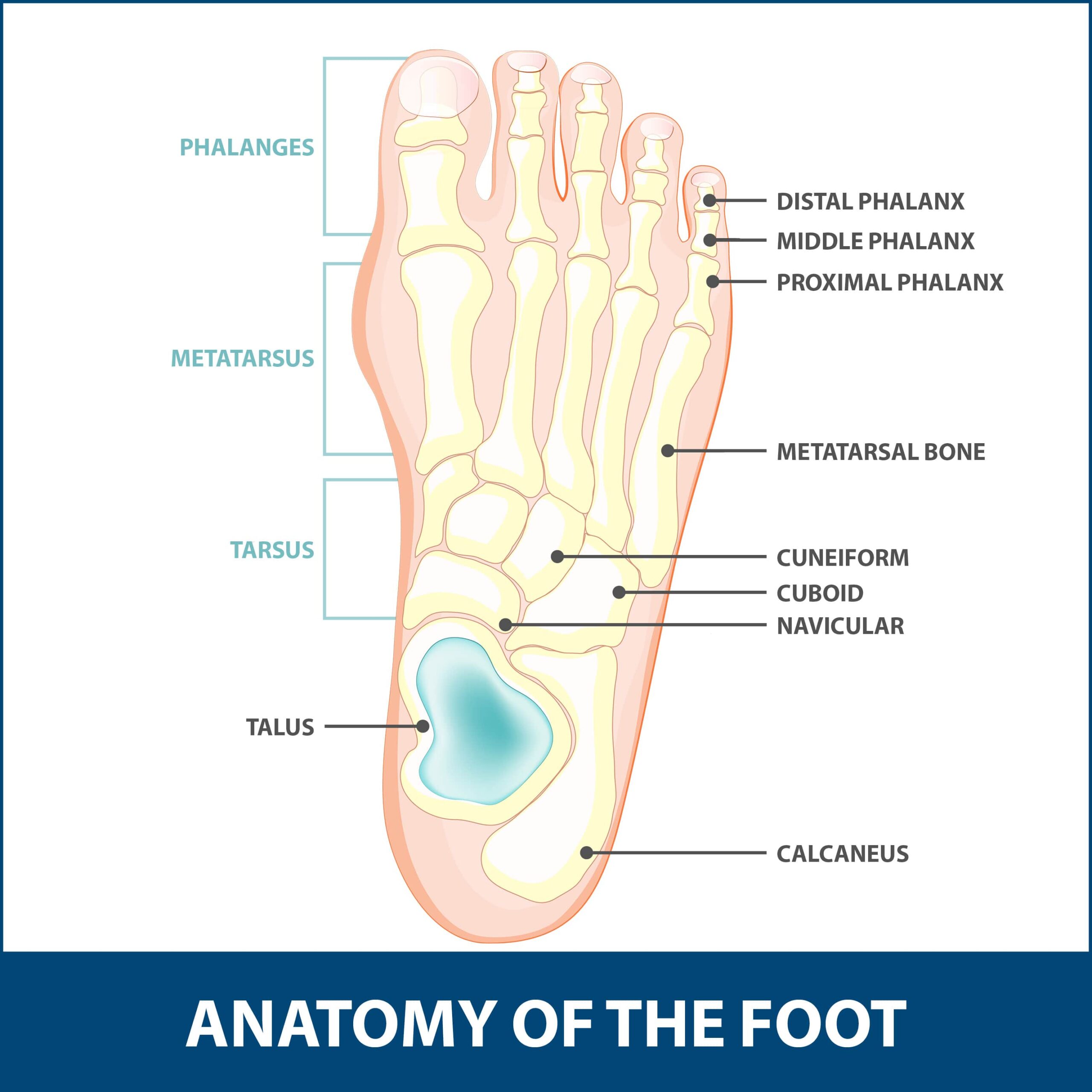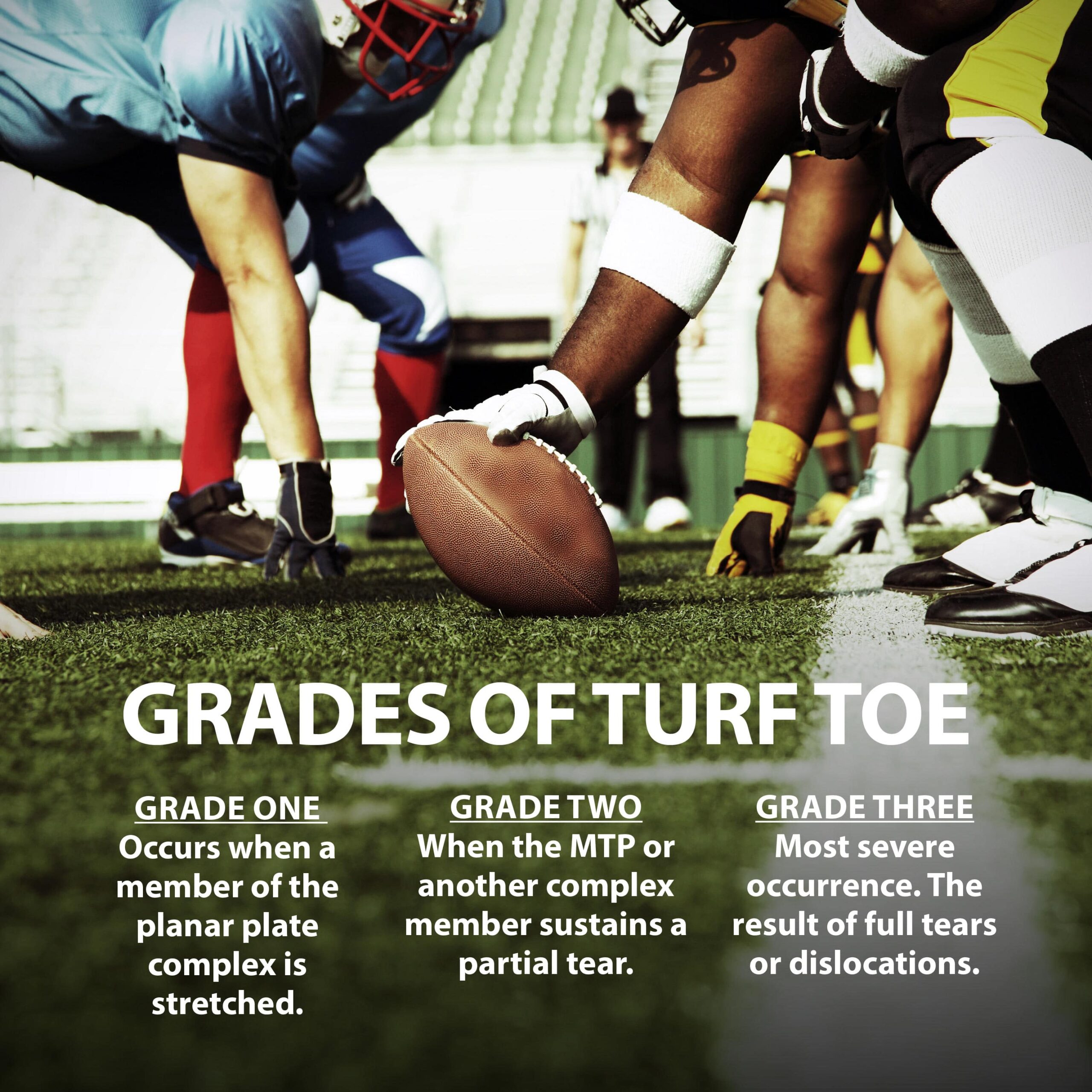Turf Toe
OVERVIEW
When you think of important physical features, you might overlook your toes and feet. However, these body parts enable people to perform basic functions like standing, walking, exercising, and supporting weight.
It should not come as a surprise that many conditions can affect them. One such issue is turf toe.
ANATOMY
This injury impacts the big toe. Your big toe contains a large joint called the metatarsophalangeal joint and is abbreviated as the MTP. The MTP attaches the metatarsal foot bone to the toe bone (the phalanx).
Additionally, the MTP is located near other important foot components, including:
- Soft tissues known as the collateral ligaments which connect the foot and toe bones.
- A tendon known as the flexor hallucis brevis.
- Two small stability-providing bones called the sesamoids.
- A thick, cushioning collection of tissue called the plantar plate.
Together, these structures form what is medically labeled the plantar complex. When turf toe occurs, any of these features also stand at risk of becoming injured.

WHAT IS TURF TOE?
Though turf toe is often associated with some type of harm being done to the MTP, the term can also refer to injury to any plantar complex feature.
Injuries to these features can range from simple overstretching to complete tears and dislocations. Damage is divided into categories of severity.
- Grade One – This simplest and least severe injury occurs when a member of the planar plate complex is stretched.
- Grade Two – Grade Two events happen when the MTP or another complex member sustains a partial tear.
- Grade Three – These most severe occurrences are the result of complete tears or dislocations.

CAUSES
Typically, these injuries are most common in athletes. Most cases strike football players. This is because they compete with the forefoot firmly planted on the ground with their heel raised. The problem occurs because this repeated, awkward position places greater pressure on the big toe and often leads to joint dislocation.
These injuries tend to occur on artificial turf surfaces because these fields are usually harder and less forgiving than natural surfaces. This fact led to the condition being named turf toe.
The shoes specially-designed for athletes to compete on artificial turf are less comfortable and harder to move in than those built for natural surfaces like grass.
SYMPTOMS
The number of symptoms and their intensity varies depending on the injury grade. However, common occurrences include:
- Pain at the big toe’s base.
- Swelling.
- Redness.
- A clicking or popping sound when the impacted toe is moved.
In more serious cases, you may have trouble moving the toe or bearing weight on the foot. Moreover, mild injuries could worsen if not properly diagnosed and treated.

DIAGNOSIS
During the early stages of examination, a doctor will carefully examine the injured toe and measure the MTP joint’s motion range. If the range is limited, they may bend the toe in several different directions. Moderate to severe tears or dislocations will limit movement or cause more intense discomfort.
If the previous tests do not provide the doctor enough evidence to confirm a diagnosis, the patient may need to undergo diagnostic imaging tests such as X-rays or MRI scans (magnetic resonance imaging).
TREATMENT OVERVIEW
Most cases of turf toe can be treated using non-surgical methods. Surgical intervention is usually only performed to correct the most severe soft tissue tears or joint dislocations.
NON-SURGICAL TREATMENTS
Most Grade One and Two injuries can be treated using non-surgical therapies.
The initial treatment for many Grade One events is the R.I.C.E. first aid method. This acronym is short for resting, applying ice, compressing, and elevating the injured toe.
If further treatment is necessary, the use of orthotic devices designed to provide additional cushioning can be inserted into one’s shoes. Occasionally, more significant Grade One events are treated with corticosteroid injections.
Grade Two injuries will likely require a period of immobilization. Items like thick tape or walking boots prevent the damaged joint or soft tissues from moving and sustaining further damage. The immobilization period typically lasts from several days to two full weeks.
In addition to restricted mobility, treatment should also include therapies used to remedy Grade One events.
Grade Three concerns are often immobilized for several weeks inside walking boots or casts. A course of physical therapy might also be needed. These medically-supervised exercises help the toe and surrounding areas regain strength and mobility.
SURGICAL INTERVENTION
The most serious Grade Three incidents usually benefit from surgery. The specific type of operations will be performed to remove injured tissue, repair damaged joints, reposition dislocations, and improve the strength and motion of the MTP and other plantar complex features.
Regardless of the specific operation, surgery will likely be followed by several weeks or months of physical therapy.
PREVENTION
At-risk athletes like football players may be able to prevent turf toe by engaging in actions, such as taping their big toe before games, placing orthotic devices in their shoes, wearing comfortable, well-fitting footwear, and, whenever possible, training on more foot-friendly surfaces like grass.
NEXT STEPS
People experiencing the symptoms of turf toe should not ignore them. Professional evaluation is key to a proper diagnosis, appropriate treatment, and a fast, uncomplicated recovery.
Talk to your Florida Orthopaedic Institute physician today to learn more about turf toe.
Areas of Focus
- Foot, Ankle & Lower Leg
- Achilles Tendinitis - Achilles Insertional Calcific Tendinopathy (ACIT)
- Achilles Tendon Rupture
- Achilles Tendonitis
- Ankle Fracture Surgery
- Ankle Fractures (Broken Ankle)
- Ankle Fusion Surgery
- Arthroscopic Articular Cartilage Repair
- Arthroscopy Of the Ankle
- Bunions
- Charcot Joint
- Common Foot Fractures in Athletes
- Foot Stress Fractures
- Hallux Rigidus Surgery - Cheilectomy
- Hammer Toe
- High Ankle Sprain (Syndesmosis Ligament Injury)
- Intraarticular Calcaneal Fracture
- Lisfranc Injuries
- Mallet, Hammer & Claw Toes
- Metatarsalgia
- Morton’s Neuroma
- Neuromas (Foot)
- Orthopedic Physician Or A Podiatrist? Definition of a Podiatrist
- Plantar Fasciitis
- Sports Foot Injuries
- Sprained Ankle
- Total Ankle Replacement
- Turf Toe
The following Florida Orthopaedic Institute physicians specialize in Turf Toe:
Specialties
- AC Joint Injuries
- Achilles Tendinitis - Achilles Insertional Calcific Tendinopathy (ACIT)
- Achilles Tendon Rupture
- Achilles Tendonitis
- ACL Injuries
- Ankle Fracture Surgery
- Ankle Fractures (Broken Ankle)
- Ankle Fusion Surgery
- Anterior Cervical Corpectomy & Discectomy
- Arthroscopic Articular Cartilage Repair
- Arthroscopic Chondroplasty
- Arthroscopic Debridement of the Elbow
- Arthroscopy Of the Ankle
- Articular Cartilage Restoration
- Artificial Disk Replacement (ADR)
- Aspiration of the Olecranon Bursa - Fluid In Elbow
- Atraumatic Shoulder Instability
- Avascular Necrosis (Osteonecrosis)
- Bankart Repair
- Basal Joint Surgery
- Bicep Tendon Tear
- Bicep Tenodesis
- Bone Cement Injection
- Bone Growth Stimulation
- Bone Health Clinic
- Broken Collarbone
- Bunions
- Bursitis of the Shoulder (Subacromial Bursitis)
- Calcific Tendinitis of the Shoulder
- Carpal Tunnel Syndrome
- Charcot Joint
- Chiropractic
- Clavicle Fractures
- Colles’ Fractures (Broken Wrist)
- Common Foot Fractures in Athletes
- Community Outreach
- Cubital Tunnel Syndrome
- De Quervain's Tenosynovitis
- Deep Thigh Bruising
- Degenerative Disk Disease
- Diffuse Idiopathic Skeletal Hyperostosis (DISH)
- Discectomy
- Discitis Treatment & Information
- Dislocated Shoulder
- Dupuytren’s Disease
- Elbow
- Elbow Bursitis
- Elbow Injuries & Inner Elbow Pain in Throwing Athletes
- Epidural Injections for Spinal Pain
- Finger Dislocation
- Flexor Tendonitis
- Foot Stress Fractures
- Foot, Ankle & Lower Leg
- Foraminotomy
- Fractured Fingers
- Fractures Of The Shoulder Blade (Scapula)
- Fractures Of The Tibial Spine
- Functional Nerve Transfers of The Hand
- Ganglion Cysts
- General Orthopedics
- Glenoid Labrum Tear
- Golfer's Elbow
- Groin Strains and Pulls
- Growth Plate Injuries Of The Elbow
- Hallux Rigidus Surgery - Cheilectomy
- Hammer Toe
- Hamstring Injuries
- Hand & Finger Replantation
- Hand & Wrist
- Hand Nerve Decompression
- Hand Skin Grafts
- Hand, Wrist, Elbow & Shoulder
- Heat Injury/Heat Prostration
- High Ankle Sprain (Syndesmosis Ligament Injury)
- Hip & Thigh
- Hip Arthroscopy
- Hip Dislocation
- Hip Flexor Strains
- Hip Fractures
- Hip Hemiarthroplasty
- Hip Impingement Labral Tears
- Hip Muscle Strains
- Hip Pointers and Trochanteric Bursitis
- Hyperextension Injury of the Elbow
- Iliopsoas Tenotomy
- Iliotibial Band Syndrome
- Impingement Syndrome of the Shoulder
- Interlaminar Implants
- Interlaminar Lumbar Instrumental Fusion: ILIF
- Interventional Pain Management
- Interventional Spine
- Intraarticular Calcaneal Fracture
- Joint Replacement
- Knee & Leg
- Kyphoplasty (Balloon Vertebroplasty)
- Kyphosis
- Labral Tears Of The Hip (Acetabular Labrum Tears)
- Laminectomy: Decompression Surgery
- Lateral Collateral Ligament (LCL) Injuries
- Lisfranc Injuries
- Little League Shoulder
- LITTLE LEAGUER'S ELBOW (MEDIAL APOPHYSITIS)
- Lumbar Epidural Steroid Injection
- Lumbar Interbody Fusion (IBF)
- MACI
- Mallet, Hammer & Claw Toes
- Medial Collateral Ligament Injuries
- Meniscus Tears
- Metatarsalgia
- Minimally Invasive Spine Surgery
- Morton’s Neuroma
- Muscle Spasms
- Muscle Strains of The Calf
- Nerve Pain
- Neuromas (Foot)
- Neurosurgery
- Olecranon Stress Fractures
- Orthopaedic Total Wellness
- Orthopaedic Trauma
- Orthopedic Physician Or A Podiatrist? Definition of a Podiatrist
- Osteoarthritis of the Hip
- Osteoporosis
- Outpatient Spine Surgery
- Partial Knee Replacement
- Patellar Fracture
- Pelvic Ring Fractures
- Peripheral Nerve Surgery (Hand) Revision
- Pinched Nerve
- Piriformis Syndrome
- Piriformis Syndrome
- Plantar Fasciitis
- Plastic Surgery
- Podiatry
- Primary Care Sports Medicine
- Quadriceps Tendon Tear
- Radial Tunnel Syndrome (Entrapment of the Radial Nerve)
- Revascularization of the Hand
- Reverse Total Shoulder Replacement
- Rheumatoid Arthritis (RA) of the Shoulder
- Rheumatoid Arthritis Of The Hand
- Robotics
- Rotator Cuff Tears
- Runner's Knee
- Sacroiliac Joint Pain
- Sciatica
- Scoliosis
- Senior Strong
- Shin Splints
- Shoulder
- Shoulder Arthritis
- Shoulder Arthroscopy
- Shoulder Injury: Pain In The Overhead Athlete
- Shoulder Replacement
- Shoulder Separations
- Shoulder Socket Fracture (Glenoid Fracture)
- SLAP Tears & Repairs
- Spinal Fusion
- Spine
- Spondylolisthesis and Spondylolysis
- Sports Foot Injuries
- Sports Hernias (Athletic Pubalgia)
- Sports Medicine
- Sports Wrist and Hand Injuries
- Sprained Ankle
- Sprained Wrist Symptoms and Treatment
- Subacromial Decompression
- Sudden (Acute) Finger, Hand & Wrist Injuries
- Targeted Muscle Reinnervation (TMR)
- Tendon Transfers of The Hand
- Tennis Elbow Treatment
- Thigh Fractures
- Thigh Muscle Strains
- Thumb Ulnar Collateral Ligament Injuries
- Total Ankle Replacement
- Total Hip Arthroplasty
- Total Hip Replacement - Anterior Approach
- Total Knee Replacement Surgery
- Trapezius Strain (Muscle Strain of The Upper Back)
- Traumatic Shoulder Instability
- Tricep Pain & Tendonitis
- Trigger Finger
- Turf Toe
- UCL (Ulnar Collateral Ligament) Injuries
- Ulnar Neuritis
- Valgus Extension Overload
- Vertebroplasty
- WALANT (Wide Awake Local Anesthesia No Tourniquet)
- Whiplash and Whiplash Associated Disorder (WAD)
- Wound Care
- Wrist Arthroscopy
- Wrist Fractures
- Wrist Tendonitis
Services
- Physical Medicine & Rehabilitation
- Physical Therapy
- Primary Care Sports Medicine
- PROMs (Patient-Reported Outcome Measures)
- Same-Day Orthopaedic Appointments Now Available
- Sports Medicine
- Sports-Related Concussion Treatment
- Telehealth Page
- Telemedicine
- Workers' Compensation
- Workers' Compensation Dispensary
- X-Ray
